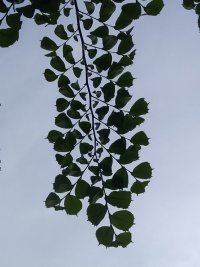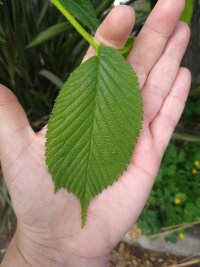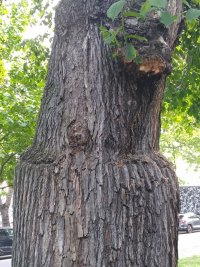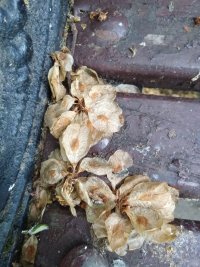You are using an out of date browser. It may not display this or other websites correctly.
You should upgrade or use an alternative browser.
You should upgrade or use an alternative browser.
What is this bush/tree/plant?
- Thread starter mrs quoad
- Start date
gentlegreen
I hummus, therefore I am ...
it's got a sorbussy look, but also sumach / tropical legume ...
Last edited:
Calamity1971
If Mr Peanut says It's okay, then it is.
Definitely staghorn. Can't see the other one properly.I know what's in these two pots but my mind's gone totally blank when I try to name them and asking here will probably be quicker than trying to google or waiting for it to come back to me
View attachment 320405
Last edited:
gentlegreen
I hummus, therefore I am ...
Coincidentally I bought some sumach powder yesterday - not sure why - doubtless something will appear demanding it - hummus perhaps... 
I'm intrigued by the whole mango-cashew-pistachio-poison ivy thing ...

I'm intrigued by the whole mango-cashew-pistachio-poison ivy thing ...
Artaxerxes
Look out, he's got a gnu!
Artaxerxes
Look out, he's got a gnu!
Did you mean the insect?
The plant is some type of fern, no idea about the bug though!
Yeah the bug! The ferns are all sprouting in the forest and curious what this guy is
Calamity1971
If Mr Peanut says It's okay, then it is.
This maybe.Yeah the bug! The ferns are all sprouting in the forest and curious what this guy is
Scorpion Fly | NatureSpot
Artaxerxes
Look out, he's got a gnu!
Oh nice,that looks likely
blossie33
trailer trash
I liked this part of the description  ..
..
can be a dangerous time for the male, if he is not careful the female might decide to kill him! To avoid this he presents her with a gift of a drop of saliva which, it seems, in the world of scorpion flies, is the equivalent of a bunch of roses or a box of chocolates.
 ..
..can be a dangerous time for the male, if he is not careful the female might decide to kill him! To avoid this he presents her with a gift of a drop of saliva which, it seems, in the world of scorpion flies, is the equivalent of a bunch of roses or a box of chocolates.
gentlegreen
I hummus, therefore I am ...
poppy (oriental ?)This? It's popped up out of top soil and is bullying the wallflowers....but its now got a furry bloom, I'm thinking poppy or a vegetable?
Calamity1971
If Mr Peanut says It's okay, then it is.
What gentlegreen said.
StoneRoad
heckling from the back!
yup, oriental poppy gets my vote ... wait and see how big the flower gets.
e2a - papaver / poppy seeds can lie dormant for quite a long time, only germinating when the soil has been disturbed ...
although I have a couple of perennial oriental poppies in pots, which are just starting to show signs of flower shoots.
currently hidden in the greenhouse, it's gone very windy today.
e2a - papaver / poppy seeds can lie dormant for quite a long time, only germinating when the soil has been disturbed ...
although I have a couple of perennial oriental poppies in pots, which are just starting to show signs of flower shoots.
currently hidden in the greenhouse, it's gone very windy today.
Last edited:
gentlegreen
I hummus, therefore I am ...
blossie33
trailer trash
I'm not sure what it is but they are an amazing blue! I've seen a few in flower recently.Is this really a gentian ? I cheated with google ...
The photo doesn't do the blue justice.
Growing on the edge of a local community garden.
View attachment 322360
gentlegreen
I hummus, therefore I am ...
I always had them in mind as a posh plant reserved for fancy alpine gardens not hanging over a park wall on a busy road junction growing out of bark ...
Lithospermum diffusa, gentlegreen. Which is what I call it, but sometimes called lithodora (diffusa). A beautifully cear blue with no hint of purple/pink
Yeah, I (mistakenly) thought gentians were invariably tricky and acid loving...but apparently not so. I have been slowly gathering seed and teetering on the edge of another plant-y obsession.
Yeah, I (mistakenly) thought gentians were invariably tricky and acid loving...but apparently not so. I have been slowly gathering seed and teetering on the edge of another plant-y obsession.
gentlegreen
I hummus, therefore I am ...
thanksLithospermum diffusa, gentlegreen. Which is what I call it, but sometimes called lithodora (diffusa). A beautifully cear blue with no hint of purple/pink

So a boragy thing

weeeeelllll, I am not sure I would call lithospermum a borage-y thing myself., gentlegreen..but mostly because it is a tough, but small and delicate wee evergreen shrub...whereas 'borage-y' implies some robust hairy vigour along the likes of cynoglossum, alkanet, anchusa, echiums, even pulmonaria (imo)...whereas lithospermum sits more comfortably alongside omphalodes, mertensia, spring gentians and so on. They may be botanically related though (my garden knowledge is unreliable when it comes to family identification). I have l.diffusum "Grace Ward' in the most neglected bit of my whole garden - languishing, overlooked (apart from bloomtimes) and rarely watered, in an old Belfast sink, with a coupla other tough survivors such as allium senescens. subsp. montanum, nemesia and an unnamed blue salvia greggii. While aubretia, linum campanulata, various campanulas have long succumbed to drought, thuggery, loneliness etc., the lithospermum trundles on, bringing in spring with a most heartbreakingly lovely shade of blue. Everyone should have one tucked away.
Geranium dissectumThese have now got pink flowers...tiny ones. Lots have popped up...?
View attachment 322865
Callie
Pivoting
Tell me about elm trees!
I saw this today:

Pretty sure that's an elm but I thought they categorically failed to get to any decent size height north of the South downs? And possible south of these days due to Dutch elm disease.
Are these something else or am I misinformed about elms?
campanula ??
These were by the Thames in Chelsea
I saw this today:


Pretty sure that's an elm but I thought they categorically failed to get to any decent size height north of the South downs? And possible south of these days due to Dutch elm disease.
Are these something else or am I misinformed about elms?
campanula ??
These were by the Thames in Chelsea
gentlegreen
I hummus, therefore I am ...
Matricaria discoidea ?And this? There's a few, from the top soil that keeps giving.
View attachment 323022
It's about 12 inches high now.
"stinking mayweed / pineapple weed"
A member of the daisy family.

Last edited:
Yes, they are elms, Callie. Although Dutch Elm disease devastated the English elm (ulmus procera), wych elms (ulmus glabra), as well as various other varieties (such as the white elm (ulmus laevis) in my local graveyard, cork elm, Chinese elm, American elm, can be found in the landscape...as well as a few stray English elms which, because of isolation, missed out on the main wave of DED in the 70s. I think there are websites which track the location of the english elm (I know there is one for black poplar - another almost vanished tree). I am really curious now - is there any chance you can get a better photo of the seeds, as well as the leafe margins. That leaf asymmetry is one of the defining characteristics of elms (as well as those coin-shaped samaras). The Chinese elm is increasing in popularity, as a smaller ornamental tree. I still miss that iconic shape...although limes have filled the gaps to a large extent...even having that impressive stature and outline.
gentlegreen
I hummus, therefore I am ...
None listed near me sadly ,...

 conservationfoundation.co.uk
conservationfoundation.co.uk

Elm Tree | The Conservation Foundation
elm tree DO NOT EDIT OR DELETE PAGE
Callie
Pivoting
I shall wander past again this evening. They look grafted? As the trunk has a very clear demarcation but the base has similar bark to the upper part. They're fairly tall, 20-30ft (although I'm rubbish at heightYes, they are elms, Callie. Although Dutch Elm disease devastated the English elm (ulmus procera), wych elms (ulmus glabra), as well as various other varieties (such as the white elm (ulmus laevis) in my local graveyard, cork elm, Chinese elm, American elm, can be found in the landscape...as well as a few stray English elms which, because of isolation, missed out on the main wave of DED in the 70s. I think there are websites which track the location of the english elm (I know there is one for black poplar - another almost vanished tree). I am really curious now - is there any chance you can get a better photo of the seeds, as well as the leafe margins. That leaf asymmetry is one of the defining characteristics of elms (as well as those coin-shaped samaras). The Chinese elm is increasing in popularity, as a smaller ornamental tree. I still miss that iconic shape...although limes have filled the gaps to a large extent...even having that impressive stature and outline.
 )
)Similar threads
- Replies
- 5
- Views
- 334
- Replies
- 50
- Views
- 2K












